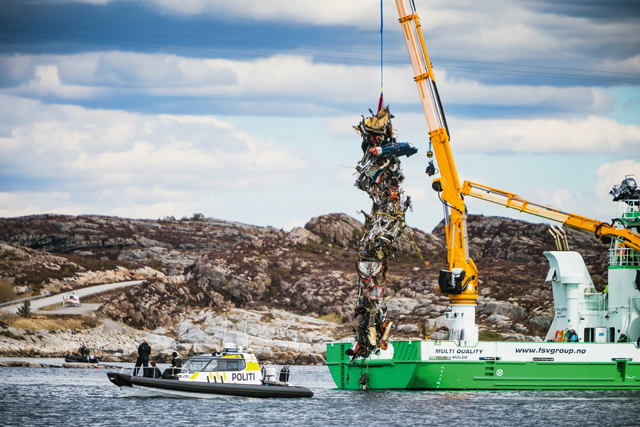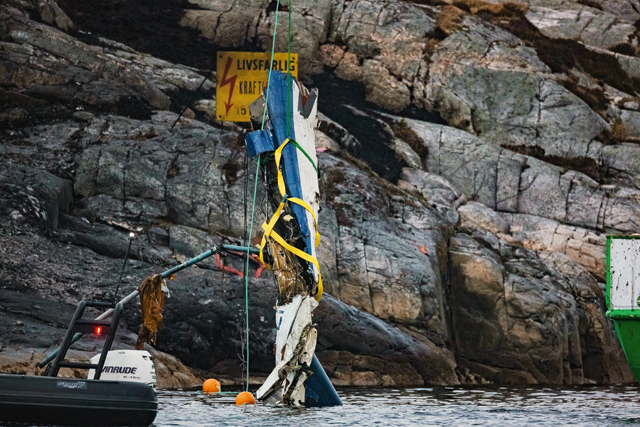European regulators may have approved the Airbus Helicopters H225’s return to full flight, but the airframer faces an enormous challenge to convince all of the industry’s stakeholders that the aircraft is safe.
Indeed, strong doubts remain among operators about the “safety barriers” put in place by the manufacturer to prevent a repeat of the 29 April crash in Norway which led to the type’s grounding.
A total of 13 passengers and crew died in that accident near the island of Turøy when a second-stage planet gear in the epicyclic module of the helicopter’s main gearbox broke up in flight, leading to the separation of the main rotor at 2,000ft.
Although the European Aviation Safety Agency lifted a flight ban on 7 October that it had imposed in June on the H225 and related AS332 L2, grounding orders are still in place on both sides of the North Sea, in the UK and Norway.
Crucially, EASA admits that the “root cause of this [gearbox] failure is still not fully understood” by the manufacturer.
However, Guillaume Faury, Airbus Helicopters chief executive, speaking shortly after EASA's decision was released, maintained that all stakeholders can eventually be convinced that the Super Puma family is safe.
“Some people say we have not understood [the root cause]. We know a lot. We are down to a small number of scenarios, which are very precise scenarios, for which we can put appropriate protections in place,” he says.
Those protections comprise inspections of the magnetic chip detectors and main gearbox oil filters every 10h, replacement of one of the two designs of second-stage plant gear which has proved less resilient in use, and a reduction of the service life on the remaining planet gear design.

Press Association
Faury is adamant that “it is not the case” that the Super Puma is no longer wanted by North Sea operators, but admits there has been “a significant loss of trust”.
That is putting mildly. Those at the sharp end of the industry are incredulous that the EASA airworthiness directive is being presented as a solution, describing a relationship with the operator which has been “soured” by the process.
“The barrier is not robust. It is currently not a final fix – that would be a change in design,” says one insider.
“None of these things mean [the second-stage planet gear] is not going to crack any more, they are just saying it’s going to be caught before it fails.”
In particular, operators point to the fact that no “impartial” body, notably Norway’s SHT accident investigation agency, has yet identified the root cause of the component failure.
Operators feel that instead of a complex design change, Airbus Helicopters is forcing the responsibility for safety of the Super Puma down to their level.
And without the root cause being fully understood, operators are also unsure precisely what it is they are looking for every 10h.
“They are offering us to detect the secondary effects of a crack for which the root cause is still unknown and that’s how Airbus claims to be guaranteeing safety. If we don’t know the root cause, we don’t know the accident sequence,” an insider adds.
Key to the EASA mandate is the assumption that the crack was initiated by the spalling found on the recovered sections of the second-stage gear, and therefore any metal fragments discovered in the chip detectors would provide warning of an issue.
However, operators point out that without a root cause, this is partly conjecture; they are concerned that a crack could begin to form without generating tell-tale metallic particles, and at the heavy reliance on engineering personnel to spot particles. This raises similarities with a previous fatal accident involving an AS332 L2 – G-REDL – which crashed in 2009 after a main gearbox failure, more of which below.
Operators also point out that many components in the gearbox can ordinarily generate particles; under these circumstances, they ask, how can you differentiate between them?
“It’s not quite a needle in a haystack, but it’s not far off: more a needle in a bunch of other needles,”says one operator. “That puts a lot of responsibility on the shoulders of a 21-year-old engineer who’s checking the [chip detectors].”

Press Association
Because of these deep reservations – and those of the offshore workforce – Faury says Airbus Helicopters will now begin a wide-ranging engagement process with all stakeholders as it looks for a full return to service for the Super Puma family.
Technical reviews of the research underpinning EASA’s decision are already under way with the UK and Norwegian civil aviation regulators, he says, “so those authorities can feel fully at ease and back the decision taken by EASA”.
In addition, it has “restarted in-depth technical discussions with operators”, he says, with a meeting held on 10 October.
However, Faury acknowledges that the process cannot be rushed and that it must proceed “step by step”. It is a “process that’s going to take time”, he says, of which EASA’s decision is only the start.
“It’s a step – a very important step – but a step among others.”
But a more forthright view – one that is unlikely to find a sympathetic ear among operators – can be found at Airbus Group level. Speaking on a third-quarter earnings call on 26 October, chief financial officer Harald Wilhelm suggested that the UK CAA was wrong to continue its grounding.
“Frankly we have to understand why they are not following EASA,” says Wilhelm, jokingly suggesting the perhaps Brexit was to blame. “The market participants can expect that if EASA lifts [the grounding], it is safe to resume [flights].”
Key to the process of returning the type to flight will be the industry safety body HeliOffshore, which has already begun assembling information on the issue for all key stakeholders.
The organisation’s chief executive, Gretchen Haskins, says Airbus Helicopters has to clear a number of “hurdles” before all parties are convinced the Super Puma is safe.
“If you don’t have a case you believe in then you can’t convince the workforce,” she says. “The reason I have been confident that this will only be returned to service when it’s safe to do so is that I know how many steps there are in the process.”
However, Haskins admits that she would not yet fly in a H225 or AS332 L2. “For me it would have to go through all the steps and it has only been through the first ones.”
Les Linklater, executive director of the pan-industry body Step Change in Safety, says he finds EASA’s decision “curious” but acknowledges he has no detail on the discussions that led up to it. However, he is full of praise for the national regulators for sticking to their guns. “The role that the UK CAA has played has been very, very welcome,” he says.
A return to service in the UK “would have been almost unthinkable”, as the workforce “is not ready to have that conversation”.
Although Linklater says anything that improves the “resilience and safety” of the Super Puma gearbox “has to be a good outcome”, he says the “communication could have been better, especially from a workforce perspective”.
He adds: “The workforce was concerned that it was coming back, and coming back before the investigation was finished. The sense was that it was premature.”
Although the state of the oil and gas industry has meant that other helicopters, mainly the Sikorsky S-92, have filled any capacity gaps, Linklater points out that relying on a single aircraft type does not build resilience into the system should anything else go wrong.
However, even on that basis he is unsure of the H225’s future. “Timing will be everything; but I don’t know if they can win hearts and minds back,” he says. “I’m not convinced that it will ever be a positive outcome for the UK workforce.”
Looming over discussions about the airworthiness of the H225 is the spectre of G-REDL – an AS332 L2 that crashed near Peterhead in Scotland on 1 April 2009 with the loss of all 16 people on board.
Airbus Helicopters has been at pains to distance the Turøy accident from the earlier disaster, pointing out that there is no evidence linking the two. Conversely, of course, until a root cause for the latest incident is discovered, a link has not been disproved, either.
And until there is a definitive conclusion either way, parallels will continue to be drawn between the two.
As one industry insider notes: “Airbus Helicopters are saying the two accidents are different, but are they? Until we know the root cause we can’t make that judgement.”
Although the crashes involved two different aircraft, as the European Aviation Safety Agency’s 2 June grounding order made plain, they use an identical gearbox.
In the case of G-REDL, the UK Air Accidents Investigation Branch (AAIB) concluded that the failure of the main gearbox “had initiated in one of the eight second-stage planet gears in the epicyclic module.”
As not all the wreckage of the helicopter was recovered, investigators were unable to determine “the precise origin” of the fatigue crack which led to the incident.
“However, analysis indicated that his is likely to have occurred in the loaded area of the planet gear outer race.”
In other words, the same component failed in both accidents in what appears to be a similar manner, with little or no warning. Of course, it is worth stressing there is no proven link between the two.
Although evidence of spalling was found in the case of G-REDL, the AAIB says that failure was initiated in a manner “which was not entirely consistent with the understood characteristics of spalling”.
This, it adds, means that the “initiation of the failure may not have been the result of spalling alone”.
A metallic particle was found on the magnetic chip detector in the days before the crash, but “the existing detection methods did not provide any further indication of the degradation of the second-stage planet gear”, the report says.
In addition, the particle was “misidentified” as being a slightly different material to the 16NCD13 steel used in the outer bearing race.
No major design changes were implemented in the gearbox following the accident, although procedures for monitoring its condition were tightened.
Source: FlightGlobal.com


























